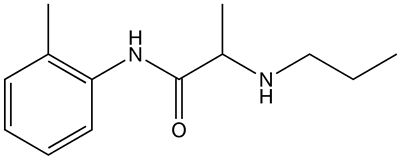Prilocaine
 | |
| Clinical data | |
|---|---|
| AHFS/Drugs.com | Monograph |
| MedlinePlus | a603026 |
| Pregnancy category |
|
| ATC code | |
| Pharmacokinetic data | |
| Protein binding | 55% |
| Metabolism | Hepatic and renal |
| Elimination half-life | 10-150 minutes, longer with impaired hepatic or renal function |
| Identifiers | |
| |
| CAS Number | |
| PubChem CID | |
| DrugBank | |
| ChemSpider | |
| UNII | |
| KEGG | |
| ChEBI | |
| ChEMBL | |
| E number | {{#property:P628}} |
| ECHA InfoCard | {{#property:P2566}}Lua error in Module:EditAtWikidata at line 36: attempt to index field 'wikibase' (a nil value). |
| Chemical and physical data | |
| Formula | C13H20N2O |
| Molar mass | 220.311 g/mol |
| 3D model (JSmol) | |
| |
| |
| (verify) | |
|
WikiDoc Resources for Prilocaine |
|
Articles |
|---|
|
Most recent articles on Prilocaine |
|
Media |
|
Evidence Based Medicine |
|
Clinical Trials |
|
Ongoing Trials on Prilocaine at Clinical Trials.gov Clinical Trials on Prilocaine at Google
|
|
Guidelines / Policies / Govt |
|
US National Guidelines Clearinghouse on Prilocaine
|
|
Books |
|
News |
|
Commentary |
|
Definitions |
|
Patient Resources / Community |
|
Patient resources on Prilocaine Discussion groups on Prilocaine Patient Handouts on Prilocaine Directions to Hospitals Treating Prilocaine Risk calculators and risk factors for Prilocaine
|
|
Healthcare Provider Resources |
|
Causes & Risk Factors for Prilocaine |
|
Continuing Medical Education (CME) |
|
International |
|
|
|
Business |
|
Experimental / Informatics |
Editor-In-Chief: C. Michael Gibson, M.S., M.D. [1]
Overview
Prilocaine /ˈpraɪl[invalid input: 'ɵ']keɪn/ is a local anesthetic of the amino amide type first prepared by Claes Tegner and Nils Löfgren. In its injectable form (trade name Citanest), it is often used in dentistry. It is also often combined with lidocaine as a preparation for dermal anesthesia (lidocaine/prilocaine or EMLA), for treatment of conditions like paresthesia. As it has low cardiac toxicity, it is commonly used for intravenous regional anaesthesia (IVRA).
In some patients, ortho-toluidine, a metabolite of prilocaine may cause methemoglobinemia, which may be treated with methylene blue.
Maximum dosage for dental use: 8.0 mg/kg (2.7 mg/lb), with a maximum dose of 500 mg.
It is given as a combination with the vasoconstrictor epinephrine under the trade name Citanest Forte.
Synthesis
Prilocaine can be synthesized from o-toluidine, 2-bromopropionyl bromide, and n-butylamine.[1]

Compendial status
Notes
- ↑ Template:Cite doi
- ↑ The United States Pharmacopeial Convention. "Revision Bulletin: Lidocaine and Prilocaine Cream–Revision to Related Compounds Test". Retrieved 10 July 2009.
See also
- Pages with script errors
- Template:drugs.com link with non-standard subpage
- E number from Wikidata
- ECHA InfoCard ID from Wikidata
- Chemical articles with unknown parameter in Infobox drug
- Infobox drug articles with non-default infobox title
- Drugs with no legal status
- Ill-formatted IPAc-en transclusions
- Local anesthetics